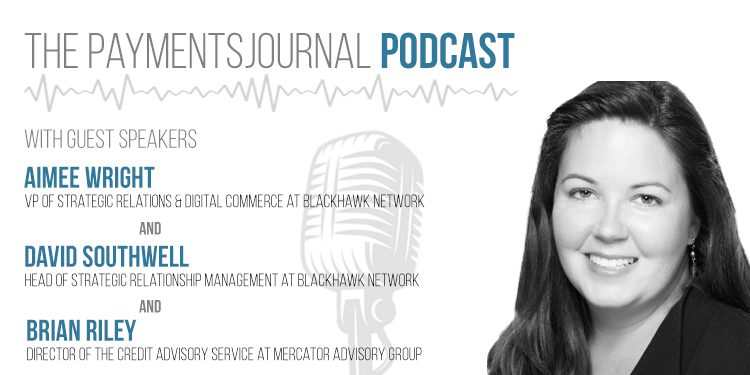In the current environment of high inflation, soaring gas prices, and threat of recession, consumers are looking to get the most out of their purchases and being judicious about where they spend their money. That is why rewards programs are more critical today than ever; merchants and businesses need the right rewards program in place to entice existing customers to continue to spend and to attract new customers. While there are many types of rewards programs businesses can offer, Blackhawk Network data points to rewards in the form of gift cards as one of the most effective.
To learn more about this trend, PaymentsJournal sat with Aimee Wright, VP of Strategic Relations & Digital Commerce at Blackhawk Network, David Southwell, Head of Strategic Relationship Management at Blackhawk Network, and Brian Riley, Director of the Credit Advisory Service at Mercator Advisory Group.
Gift Card Use Often Leads to Increased Spending
Riley noted that gift card use by consumers tends to be associated with increased spending overall.
Data from Blackhawk’s newly released 2022 study revealed that depending on the card value, up to 90% of gift card recipients are willing to spend more than the amount on the card. Overspend can range anywhere from around $50 for a $10 gift card, to over $100 for a $500 card.

Riley added that store-specific cards also provide the benefit of allowing the merchant to bypass the typical interchange fees associated with debit and credit card use.
The high degree of flexibility of gift cards also makes them appealing. Riley cited one example of flexibility: in the current environment of sky-high gas prices, grocery stores are offering discounted gas cards to customers who spend a certain amount of money at the store. Gift cards also can incorporate incentives that make them appealing, Riley said.
“There’s a component where consumers can get a gift for themselves as they give a gift,” Riley added. “Such as an offer where if they spend $100 on a card, they get a $20 card back. For the retailer, that’s a win with two potential customers now.”
What Makes Loyalty Programs Attractive
All of these reasons make gift cards an attractive reward for consumers who participate in loyalty programs. Blackhawk Network’s Aimee Wright acknowledged that “cash back has always been king in the realm of loyalty programs” but that gift cards are becoming increasingly popular. Gift cards can incent the consumer to spend within that merchant’s ecosystem and are also less expensive to manage than cash-back programs.
“For businesses, gift cards help with managing the cost of loyalty programs,” Wright said. “Cash back is the most expensive reward [for businesses], then travel and gift cards are third. So, it’s a much more appealing reward to give consumers than cash back or travel.”
Southwell added that gift cards make consumers more engaged with the specific brand associated with the card and they usually spend more time on that merchant’s website. Consumers also tend to use gift cards sooner than other rewards associated with loyalty programs. It’s no surprise then that many merchants and businesses have begun to embrace gift cards.
“Loyalty programs supported by Blackhawk Network have seen double-digit growth in the past few years,” Southwell said.
Flexible Customer Engagement
Gift cards can be distributed physically or digitally, and that is important especially as the COVID-19 pandemic drastically shifted consumer behavior. When consumers were stuck inside their house during lockdowns and could not visit friends and family for birthdays, holidays, and special occasions, they relied on sending digital gift cards, Wright said.
It’s important for loyalty programs to not only be robust, but the rewards should be delivered “in whatever channel consumers want and as timely and as fast as possible,” she added.
The experience of gift cards is also just as critical for engaging consumers. In that regard, Wright noted that Blackhawk Network has seen great success with its line of Blackhawk Originals Choice multi-brand gift cards that bring different brands together onto a themed gift card. For example, a “Retail Therapy” card can be used at a variety of fashion, beauty and home stores, and “Happy Birthday” card offers retail, restaurant and entertainment options. In addition to gift cards’ traditional use as a gift for others, Blackhawk Network research also points to the idea that gift cards are being tapped more and more for personal use and “treat yourself” moments.
Ultimately, gift cards help businesses keep the customer more engaged in their rewards programs. Wright said that while 87% of Americans belong to at least one loyalty program, with the average consumer being enrolled in six, the typical consumer only actively participates in one or two.
“Loyalty program spending is all about keeping the customer in your ecosystem so you can capture that overspend while rewarding them at the same time,” Wright said. “And the more engaged the customer is, the less likely they are to migrate to other competitors.”
The Future of Loyalty
Looking ahead, gift cards will make up a portion of consumers’ digital wallets, which will also include traditional debit and credit cards as well as airline miles and cryptocurrency, Wright said, adding that this future scenario will result in “making currency ubiquitous.”
“We are already rapidly moving toward this reality, with 88% of consumers using some form of digital wallet,” Wright said. Furthermore, “by the end of 2022, half of all digital payments will be made using nontraditional payment methods,” Wright added.
Consumers are increasingly looking at all forms of payment vehicles as currency, and gift cards will play a key role in this new payments reality.
“We’re moving into a future where consumers will use a single digital wallet where all currencies will be deposited in and can be used collectively at the point of sale,” Wright said. “And the point of sale can prompt the option to use rewards to pay for an item.”
To learn more about Blackhawk Network’s portfolio and how they can support your loyalty program, click here.










